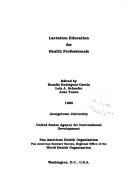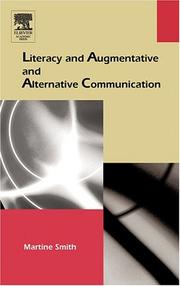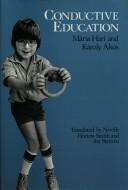| Listing 1 - 8 of 8 |
Sort by
|
Book
ISBN: 3925714405 Year: 1991 Publisher: Aachen Mainz
Abstract | Keywords | Export | Availability | Bookmark
 Loading...
Loading...Choose an application
- Reference Manager
- EndNote
- RefWorks (Direct export to RefWorks)
Education of patients --- Infirmières -- Rôle pédagogique --- Malades -- Éducation sanitaire --- Patient education --- Patients -- Education --- Patients -- Éducation sanitaire --- Patiënten -- Opvoeding --- Patiëntenopvoeding --- Sick -- Health education --- Zieken -- Opvoeding --- Éducation des malades --- Éducation des patients --- Éducation thérapeutique --- Sick children --- Education

ISBN: 9275120242 Year: 1990
Abstract | Keywords | Export | Availability | Bookmark
 Loading...
Loading...Choose an application
- Reference Manager
- EndNote
- RefWorks (Direct export to RefWorks)
Education of patients --- Infirmières -- Rôle pédagogique --- Lactatie --- Lactation --- Malades -- Éducation sanitaire --- Milk secretion --- Milk--Secretion --- Patient education --- Patients -- Education --- Patients -- Éducation sanitaire --- Patiënten -- Opvoeding --- Patiëntenopvoeding --- Sick -- Health education --- Zieken -- Opvoeding --- Éducation des malades --- Éducation des patients --- Éducation thérapeutique --- Breast Feeding --- Education, Continuing --- Health Personnel --- Breastfeeding --- Allaitement maternel --- congresses. --- education. --- Study and teaching
Multi
ISSN: 25934414 ISBN: 9782804190811 2804190811 Year: 2015 Volume: *1 Publisher: Louvain-la-Neuve : De Boeck,
Abstract | Keywords | Export | Availability | Bookmark
 Loading...
Loading...Choose an application
- Reference Manager
- EndNote
- RefWorks (Direct export to RefWorks)
Quatrième de couverture : "En s'attachant à analyser et caractériser les activités que tout sujet porteur d'une maladie chronique déploie au service de son maintien en santé et en vie, l'auteure conduit un plaidoyer pour la reconnaissance de l'expérience des malades en s'appuyant sur les travaux qu'elle a conduits dans des situations de soin inédites comme celles ayant trait au VIH/SIDA. La première partie décrit les enjeux sociaux et théoriques de la reconnaissance de l'expérience des malades et interroge les constructions théoriques ayant pour objet la catégorisation de l'expérience de la maladie. La deuxième partie décrit la complexité du travail conduit quotidiennement par les sujets en soin en mobilisant les théories de l'analyse du travail pour en rendre compte. Dans la troisième partie, l'auteure, en s'appuyant sur sa pratique d'accompagnement et de formation de sujets en soin, montre comment la maladie est l'occasion d'un redéploiement du sujet qui se trouve transformé par l'expérience qu'il vit et qu'il transforme à son tour. La quatrième partie s'attache à illustrer les implications des énoncés théoriques de l'ensemble de l'ouvrage en termes de propositions innovantes pour une pratique de l'éducation thérapeutique."
Education of patients --- Infirmières -- Rôle pédagogique --- Malades -- Éducation sanitaire --- Patient education --- Patients -- Education --- Patients -- Éducation sanitaire --- Patiënten -- Opvoeding --- Patiëntenopvoeding --- Sick -- Health education --- Zieken -- Opvoeding --- Éducation des malades --- Éducation des patients --- Éducation thérapeutique --- Éducation des patients. --- Éducation du patient comme sujet. --- Patient Education as Topic --- Patient Education as Topic. --- Chronically ill --- Education des patients --- Malades chroniques

ISBN: 1281008370 9786611008376 0080478956 1417564245 9781417564248 1592784992 9781592784998 9780080478951 0126503591 9780126503593 Year: 2005 Publisher: Amsterdam Boston Elsevier
Abstract | Keywords | Export | Availability | Bookmark
 Loading...
Loading...Choose an application
- Reference Manager
- EndNote
- RefWorks (Direct export to RefWorks)
The new demands of this "computer and technology age" have focused international attention on literacy levels, on literacy development and literacy disorders. Governments have launched programs to reduce literacy difficulties and support functional literacy for all. In this context, the needs of individuals with severe speech and physical impairments may seem relatively small, and even unimportant. However, for this group of individuals in particular unlocking the literacy code opens up tremendous opportunities, minimizing the disabling effects of their underlying speech and motor impairments, and supporting participation in society. Ironically however, for a group for whom literacy is such an important achievement, current studies suggest that achieving functional literacy skills is particularly challenging.In order to read, individuals with severe speech impairments must access a set of written symbols and decode them to abstract meaning just as anyone else must do. They must convert underlying messages into an alternative external symbol format in order to write. In order to become expert in both of these activities, they must learn at least a certain core of knowledge about how the symbols and messages relate to each other. Just as there are many ways to skin a chicken, there are many possible ways to achieve mastery of reading and writing. Although the essence of the task may remain the same for individuals with congenital speech impairments, they may process the task, or develop task mastery in ways that are quite different from speaking children who have no additional physical impairments. "Literacy and Augmentative and Alternative Communication" focuses on individuals with combined physical and communication impairments, who rely at least some of the time on aided communication. It investigates the range of research and application issues relating to AAC and literacy (primarily reading and writing skills), from the emergent literacy stage up through adulthood use of reading for various vocational and leisure purposes. It provides a balanced view of both the whole language as well as the more analytic approaches to reading instruction necessary for the development of reading skills.
Communicative disorders --- Literacy --- Illiteracy --- Education --- General education --- Communication disorders (Medicine) --- Disorders of communication --- Nervous system --- Patients --- Education. --- Study and teaching. --- Diseases --- Study and teaching --- Communicative disorders - Patients - Education --- Literacy - Study and teaching
Book
ISBN: 9242542253 9789242542257 Year: 1990 Publisher: Genève OMS
Abstract | Keywords | Export | Availability | Bookmark
 Loading...
Loading...Choose an application
- Reference Manager
- EndNote
- RefWorks (Direct export to RefWorks)
Delivery of health care --- Delivery of medical care --- Education of patients --- Gezondheidszorg --- Health care --- Health care delivery --- Health services --- Infirmières -- Rôle pédagogique --- Malades -- Éducation sanitaire --- Mass media en éducation sanitaire --- Mass media in health education --- Massamedia in de gezondheidsopvoeding --- Medical and health care industry --- Medical care --- Medical services --- Patient education --- Patients -- Education --- Patients -- Éducation sanitaire --- Patiënten -- Opvoeding --- Patiëntenopvoeding --- Personal health services --- Services médicaux --- Sick -- Health education --- Soins médicaux --- Zieken -- Opvoeding --- Éducation des malades --- Éducation des patients --- Éducation thérapeutique --- Health Education --- Health Occupations --- education. --- HEALTH OCCUPATIONS --- education --- Health occupations --- Education.
Book
ISSN: 07681992 ISBN: 9782294769313 2294769317 Year: 2020 Publisher: Issy-les-Moulineaux : Elsevier Masson,
Abstract | Keywords | Export | Availability | Bookmark
 Loading...
Loading...Choose an application
- Reference Manager
- EndNote
- RefWorks (Direct export to RefWorks)
Patient Education as Topic --- Chronic Disease --- Physician-Patient Relations --- Patient Compliance. --- Éducation des patients. --- Maladies chroniques --- Relations médecin-patient. --- Patients --- Maladie chronique. --- Éducation du patient comme sujet. --- Relations médecin-patient. --- Observance par le patient. --- psychology --- Aspect psychologique. --- Coopération. --- Patients - education --- Patient Compliance --- Patient Education as Topic. --- Physician-Patient Relations.
Book
ISBN: 1489974202 1489974210 Year: 2014 Publisher: New York, NY : Springer US : Imprint: Springer,
Abstract | Keywords | Export | Availability | Bookmark
 Loading...
Loading...Choose an application
- Reference Manager
- EndNote
- RefWorks (Direct export to RefWorks)
Sports hernias are an increasingly recognized problem in athletics, presenting a challenge for team physicians and other health care providers regarding their diagnosis and management. Confusion is magnified by the various treatment methods that exist, both surgical and non-surgical. Sports Hernia and Athletic Pubalgia is the first text devoted solely to the topic of sports hernia and will examine its etiology and diagnosis, as well as how to differentiate it from other problems involving the athlete’s hip area and other injuries it often correlates and interacts with, such as femoroacetabular impingement. It covers all current approaches to treatment, from open approaches to minimally invasive approaches, and discusses rehabilitation and return to play. Comprised of contributions from an international array of expert clinicians and thought leaders, this is the immediate authoritative book on the subject of sports hernias.
Athletic Injuries -- therapy. --- Medicine. --- Orthopedics. --- Patient education. --- Sports injuries -- Patients -- Education. --- Sports medicine. --- Surgery. --- Medicine --- Orthopedics --- Rehabilitation --- Sports medicine --- Pathological Conditions, Anatomical --- Abdomen --- Wounds and Injuries --- Body Regions --- Diseases --- Pathological Conditions, Signs and Symptoms --- Anatomy --- Groin --- Hernia --- Athletic Injuries --- Surgery & Anesthesiology --- Health & Biological Sciences --- Surgery - General and By Type --- Wounds & Injuries --- Sports injuries. --- Athletes --- Athletic injuries --- Sporting injuries --- Sports --- Wounds and injuries --- Accidents and injuries --- Medicine & Public Health. --- Sports Medicine. --- Surgery, Primitive --- Orthopaedics --- Orthopedia --- Surgery --- Athletic medicine --- Athletics --- Medicine and sports --- Physical education and training --- Sports sciences --- Medical aspects

ISBN: 0415047455 0415008670 9780415008679 9780415047456 Year: 1988 Publisher: London Routledge
Abstract | Keywords | Export | Availability | Bookmark
 Loading...
Loading...Choose an application
- Reference Manager
- EndNote
- RefWorks (Direct export to RefWorks)
Neuromuscular diseases --- Conductive education --- Patients --- Rehabilitation --- Education --- Infant. --- Child. --- Central Nervous System Diseases. --- Education, Special. --- Neurologic Manifestations. --- Neuromuscular Diseases. --- -Neuromuscular diseases --- -159.91 --- Neuromotor disorders --- Neuromuscular disorders --- Muscles --- Nervous system --- Cramp-Fasciculation Syndrome --- Fasciculation-Cramp Syndrome, Benign --- Foley-Denny-Brown Syndrome --- Oppenheim's Disease --- Amyotonia Congenita --- Oppenheim Disease --- Benign Fasciculation-Cramp Syndrome --- Benign Fasciculation-Cramp Syndromes --- Cramp Fasciculation Syndrome --- Cramp-Fasciculation Syndromes --- Fasciculation Cramp Syndrome, Benign --- Fasciculation-Cramp Syndromes, Benign --- Foley Denny Brown Syndrome --- Neuromuscular Disease --- Oppenheims Disease --- Syndrome, Cramp-Fasciculation --- Syndrome, Foley-Denny-Brown --- Syndromes, Cramp-Fasciculation --- Focal Neurologic Deficits --- Manifestations, Neurologic --- Manifestations, Neurological --- Neurologic Dysfunction --- Neurologic Findings --- Neurologic Manifestation --- Neurologic Signs --- Neurologic Symptoms --- Neurological Manifestations --- Neurologic Deficits --- Neurologic Signs and Symptoms --- Deficit, Focal Neurologic --- Deficit, Neurologic --- Deficits, Focal Neurologic --- Deficits, Neurologic --- Dysfunction, Neurologic --- Dysfunctions, Neurologic --- Finding, Neurologic --- Findings, Neurologic --- Focal Neurologic Deficit --- Manifestation, Neurologic --- Manifestation, Neurological --- Neurologic Deficit --- Neurologic Deficit, Focal --- Neurologic Deficits, Focal --- Neurologic Dysfunctions --- Neurologic Finding --- Neurologic Sign --- Neurologic Symptom --- Neurological Manifestation --- Sign, Neurologic --- Signs, Neurologic --- Symptom, Neurologic --- Symptoms, Neurologic --- Nervous System --- Special Education --- Educations, Special --- Special Educations --- Disabled Persons --- CNS Diseases --- Central Nervous System Disorders --- CNS Disease --- Children --- Minors --- Infants --- -Education --- -Rehabilitation --- Psychofysiologie. Neuropsychologie. Psychomotoriek. Psychomotorische therapie --- Diseases --- 159.91 Psychofysiologie. Neuropsychologie. Psychomotoriek. Psychomotorische therapie --- Central Nervous System Disease --- Central Nervous System Disorder --- Infant --- Child --- Central Nervous System Diseases --- Education, Special --- Neurologic Manifestations --- Neuromuscular Diseases --- Neuromuscular diseases - Patients - Rehabilitation --- Neuromuscular diseases - Patients - Education --- -Patients
| Listing 1 - 8 of 8 |
Sort by
|

 Search
Search Feedback
Feedback About UniCat
About UniCat  Help
Help News
News